Starting your fitness journey can feel like trying to find your way through a maze without a map.
Picture yourself confidently strolling onto the beach, proud of your toned body that shows off all your hard work.
But getting there can be tough.
You’re bombarded with so much advice, it’s hard to know where to start. Did you know it takes about 66 days (about 2 months) to form a new habit? [*]
But what if I told you there’s a way to make this whole process simpler?
Imagine being able to build muscle and burn fat at the same time, sculpting the body you’ve always wanted.
That’s where body recomposition comes in. It’s a smart approach that uses science to help you transform your body without all the confusion.
So, let’s dive in and discover how you can make your fitness dreams a reality.
Understanding the Process of Muscle Building and Fat Loss for Beginners

Imagine stepping onto the beach with confidence, feeling toned and sculpted.
You finally love what you see in the mirror, and your clothes fit perfectly.
But the journey to get there can feel confusing.
What if you could build muscle and burn fat at the same time?
This elusive concept, known as body recomposition, might seem like magic, but it’s actually based on sound science.
The Great Physique Puzzle: Putting the Pieces Together
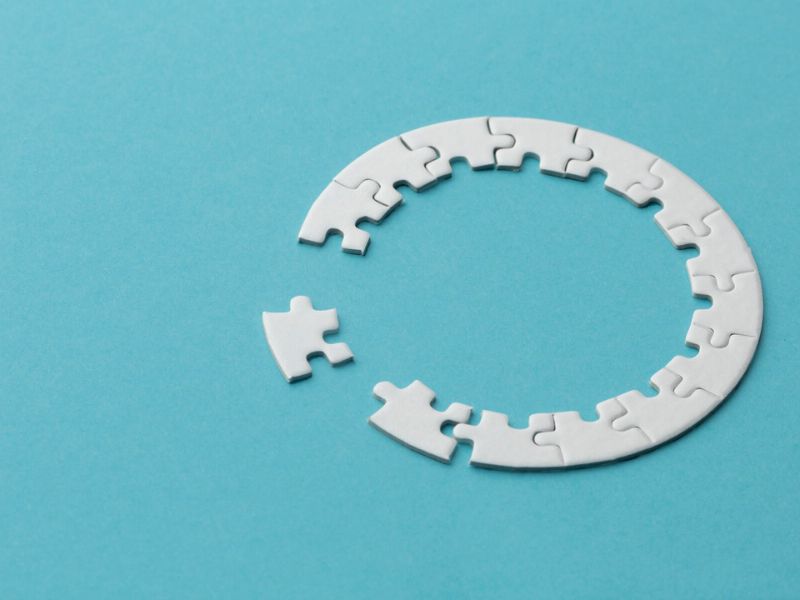
Let’s face it, most fitness advice falls into two categories: “build muscle” or “lose fat.” But what if you could achieve both? That’s the beauty of body recomposition.
Here’s a breakdown of the two key players involved:
- Muscle Building: Think of your muscles as the calorie-burning furnaces in your body. The more muscle mass you have, the higher your Basal Metabolic Rate (BMR). This is essentially the number of calories your body burns at rest. Studies published in the National Institutes of Health show that even a small increase in muscle mass can significantly boost your metabolism, making it easier to burn fat and maintain a healthy weight [*].
- Fat Loss: Shedding unwanted body fat is all about creating a calorie deficit. This means burning more calories than you consume. But here’s the catch: if your calorie deficit is too drastic, your body might start breaking down muscle tissue for energy, hindering your progress.
The Hormonal Symphony: Conducting Muscle Growth and Fat Loss

But here’s the interesting part: building muscle and burning fat are influenced by a complex interplay of hormones.
When you engage in strength training, you create tiny tears in your muscle fibers (don’t worry, this is a good thing.).
This triggers a cascade of hormonal responses, including a surge in testosterone and growth hormone.
These hormones act like conductors in an orchestra, directing your body to play the beautiful melody of muscle protein synthesis – the process of building new muscle tissue.
However, another hormone called cortisol can act like a rogue violinist, throwing the whole symphony off key.
Cortisol, often elevated by stress and excessive cardio, can actually promote muscle breakdown.
This is why prioritizing rest and recovery becomes crucial.
By getting enough sleep and incorporating active recovery techniques like stretching and yoga, you can keep cortisol levels in check and optimize muscle growth.
Sources:
- https://journals.lww.com/menopausejournal/fulltext/2018/06000/Comparisons_of_low_intensity_versus.16.aspx
Understanding Calorie Balance and Macronutrients

We cracked the code on the importance of calorie balance and hormones for body recomposition.
But what about the fuel that keeps this whole engine running?
That’s where macronutrients step in: the proteins, carbohydrates, and fats that make up your diet.
Let’s revisit our beach bod dreamer from earlier. They might be hitting the gym consistently, but progress feels sluggish.
Maybe they’re following a fad diet that’s low in protein or healthy fats, or perhaps they’re simply unsure of how much to eat.
Here's the good news: By understanding your macronutrient needs and making smart choices, you can transform your diet from a frustrating puzzle into a powerful tool for sculpting your physique.
Calorie Control: A Tailored Approach

Remember the calorie bank analogy? Just like different bank accounts have different goals, your calorie intake strategy depends on your specific recomposition goals.
Here’s a breakdown:
- Fat Loss: To shed fat, you’ll need to be in a calorie deficit. A good starting point is a deficit of 500-1000 calories per day. This deficit shouldn’t be too drastic, as research suggests it can lead to muscle loss [*].
- Muscle Building and Fat Loss (Recomposition): This requires a more nuanced approach. Aiming for a slight calorie deficit or even maintenance (consuming the same calories you burn) can be effective, especially for beginners. Strength training will help build muscle, which in turn increases your metabolism and aids in burning fat.
A good starting point is to use a Total Daily Energy Expenditure (TDEE) calculator. These online tools take into account your age, weight, height, activity level, and even your sex to estimate the number of calories your body burns each day.

Once you have your TDP, you can create a slight deficit for body recomposition.

Protein: The Building Block Superstar

Protein is the MVP of muscle building. It provides the amino acids your body needs to repair and grow muscle tissue.
Studies have shown that consuming 0.8-1 gram of protein per pound of bodyweight daily is optimal for muscle growth while in a calorie deficit [*].
Search for a protein calculator online. Input your weight and see how much protein you should aim for each day. This will help you tailor your meals to fuel your muscle-building journey.

Think about your current protein intake. Are you hitting your target?
Here’s a fun challenge: for the next 3 days, track your protein intake using a free app or website.
Once you have that number, reply in the comments below and let’s see if we can brainstorm some delicious, protein-rich meal ideas to reach your goals.
Carbs and Fats: Not the Enemy.
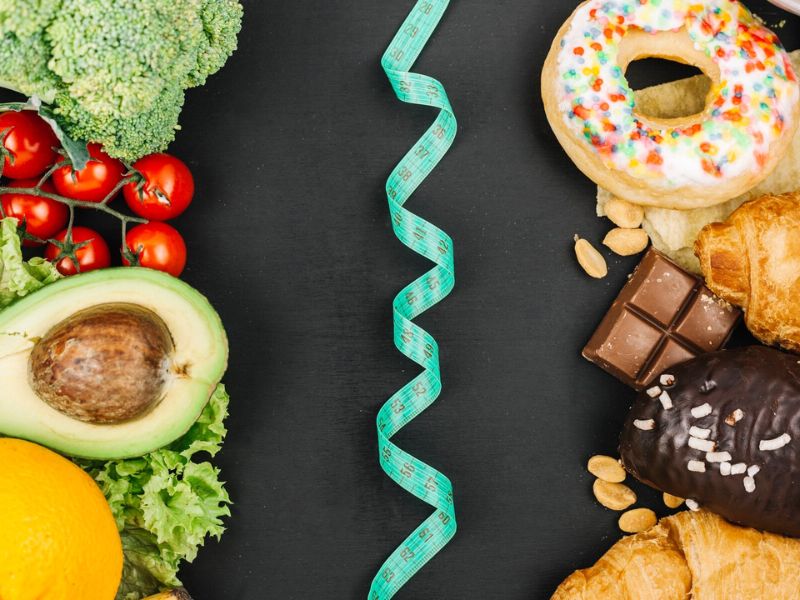
Carbs and fats are often demonized in fad diets, but they play crucial roles in body recomposition. Here’s a quick rundown:
- Carbohydrates: Fuel your workouts and provide energy for daily activities. Complex carbs like whole grains, fruits, and vegetables are your best bet for sustained energy and fiber intake.
- Fats: Provide essential fatty acids, support hormone production, and help you feel satiated. Healthy fats like those found in avocados, nuts, and fatty fish are key components of a well-rounded diet.
The Art of Macronutrient Adjustment
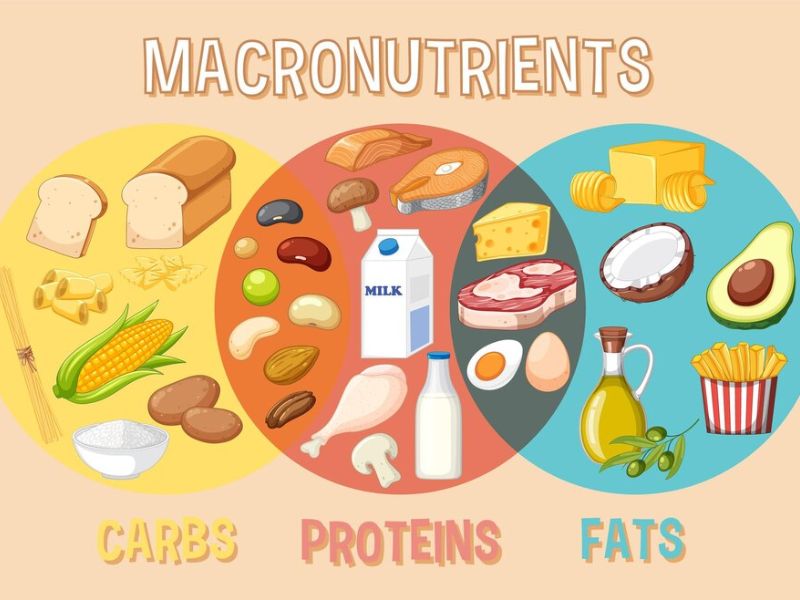
As you progress on your recomposition journey, your needs may change. Here’s how to adjust your macronutrients:
- Not Losing Fat? You might need to increase your calorie deficit slightly. However, prioritize small adjustments to avoid muscle loss.
- Feeling Sluggish During Workouts? Up your carb intake before exercise to provide readily available energy.
- Struggling with Satiety? Healthy fats can help you feel fuller for longer.
Remember, there's no one-size-fits-all approach. Experiment, track your progress, and don't be afraid to seek guidance from a registered dietitian or certified personal trainer for personalized recommendations.
Building Muscle Through Strength Training

Imagine this: you’ve dialed in your calorie intake, but those stubborn fat rolls seem to be holding on for dear life. Feeling discouraged?
Here’s the truth: strength training, often called muscle building, is the missing puzzle piece for unlocking your muscle-building and fat-burning potential.
Think of your body’s metabolism as a furnace. The more muscle mass you have, the hotter the furnace burns, torching more calories throughout the day, even at rest.
Research published in the Journal of Strength and Conditioning Research shows that strength training can increase your resting metabolic rate by up to 10%, making it significantly easier to achieve your fat-loss goals [*].
But strength training isn’t just about aesthetics (although that sculpted physique is a nice perk.).
It strengthens your bones, improves joint health, and boosts your overall fitness level.
Still not convinced? Here’s why strength training should be your new best friend:
Why Strength Training Reigns Supreme?
Think of your body’s metabolism as a furnace. The more muscle mass you have, the hotter the furnace burns, torching more calories even at rest.
But strength training isn’t just about burning calories; it’s the key to building a sculpted physique.
As you lift weights and challenge your muscles, tiny tears occur in the muscle fibers.
Don’t panic, this is a good thing. Your body responds by repairing and rebuilding these fibers, making them stronger and thicker over time.
This process, called muscle protein synthesis, is what sculpts those enviable muscles you see in fitness magazines.
Sample Beginner Strength Training Routine:
This routine follows a Push-Pull-Legs (PPL) split, meaning you focus on different muscle groups each day. Rest days are crucial for muscle recovery, so don’t skip them.
Day 1: Push (Exercises that target your chest, shoulders, and triceps)

- Dumbbell Bench Press: Lie on a flat bench with dumbbells in each hand. Press the weights straight up towards the ceiling, then slowly lower them back down to chest level. (3 sets of 8-12 repetitions)
- Dumbbell Shoulder Press: Sit upright on a bench and hold dumbbells at shoulder level. Press the weights straight up overhead, then lower them back down with control. (3 sets of 8-12 repetitions)
- Tricep Extensions: Sit on a bench and hold dumbbells behind your head, elbows bent at 90 degrees. Extend your arms straight back, then lower the weights back down with control. (3 sets of 8-12 repetitions)
Day 2: Rest
Day 3: Pull (Exercises that target your back and biceps)
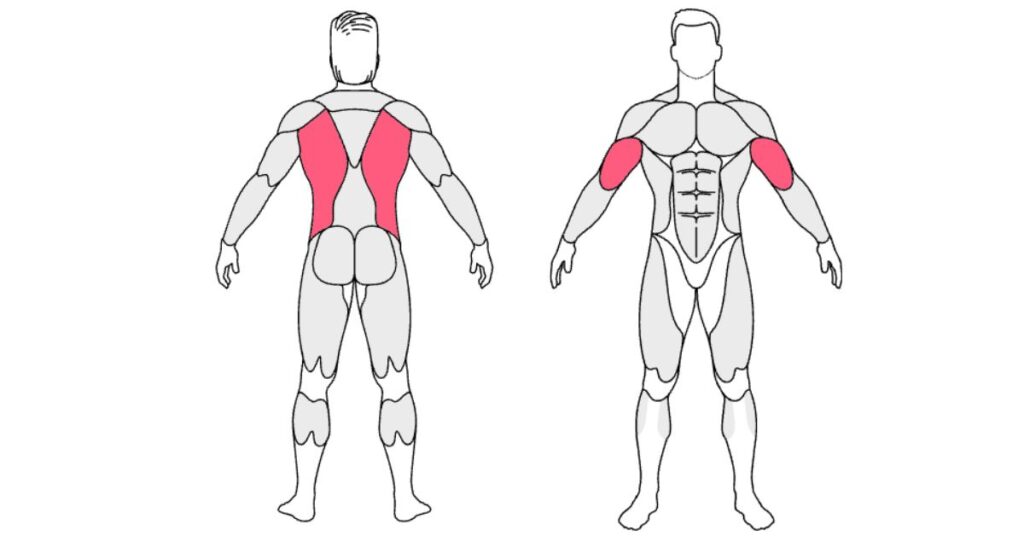
- Barbell Rows: Stand with your feet shoulder-width apart and bend at the hips, keeping your back straight. Grab a barbell with an overhand grip and row the weights towards your chest, squeezing your shoulder blades together. (3 sets of 8-12 repetitions)
- Lat Pulldown: Sit on a lat pulldown machine and grab the bar with a wide grip. Pull the bar down towards your chest, keeping your back straight. (3 sets of 8-12 repetitions)
- Bicep Curls: Stand with dumbbells in each hand at your sides. Curl the weights up towards your shoulders, squeezing your biceps at the top. (3 sets of 8-12 repetitions)
Day 4: Rest
Day 5: Legs (Exercises that target your quads, hamstrings, and calves)
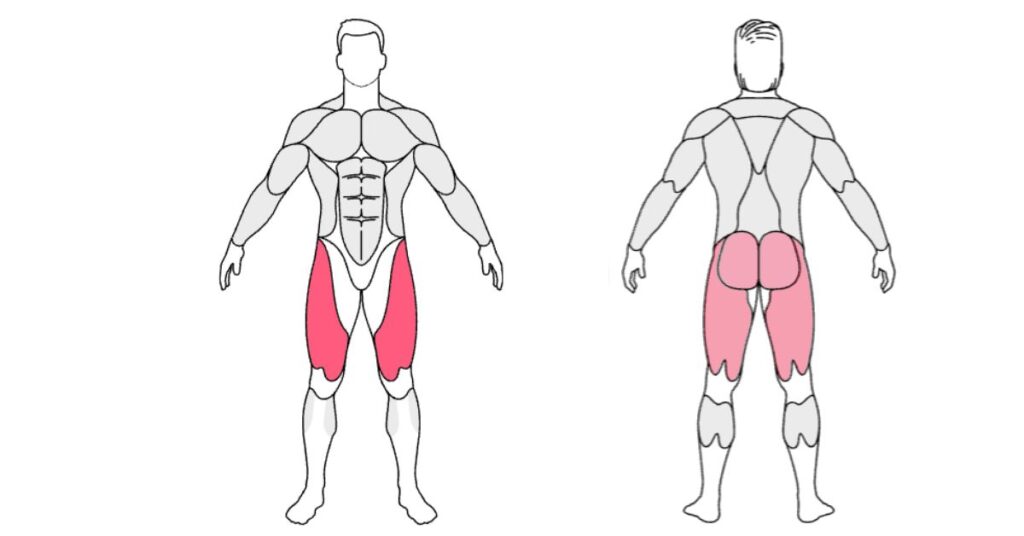
- Squats: Stand with your feet shoulder-width apart and toes pointed slightly outward. Lower yourself down as if you’re going to sit in a chair, keeping your back straight and core engaged. Push through your heels to stand back up. (3 sets of 8-12 repetitions)
- Lunges: Step forward with one leg and lower your body down until both knees are bent at 90-degree angles. Push through your front heel to return to standing. Repeat on the other leg. (3 sets of 8-12 repetitions per leg)
- Calf Raises: Stand on a calf raise machine or step and raise yourself onto your tiptoes. Hold for a second at the top, then lower your heel back down with control. (3 sets of 15-20 repetitions)
Day 6 & 7: Rest
Form is King: Safety and Efficiency First.

Using proper form during your workouts is crucial to prevent injuries and maximize results. Here are some golden rules:
- Focus on quality over quantity. It’s better to use a lighter weight with proper form than a heavier weight that compromises your technique.
- Mind the muscle-mind connection. Focus on feeling the targeted muscle group working throughout the exercise.
- Don’t be afraid to ask for help. If you’re unsure about a particular exercise, consult a certified personal trainer for guidance.
Progressive Overload: The Key to Continuous Growth
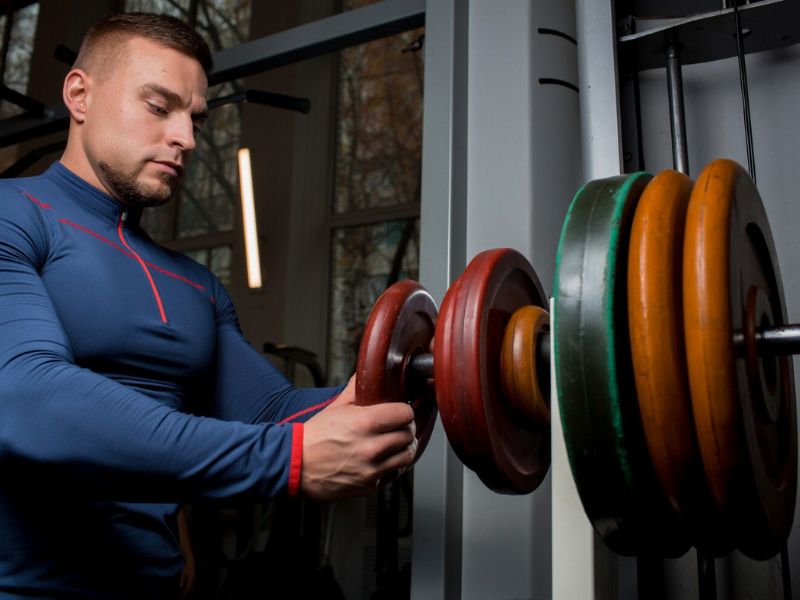
Your muscles are clever little things. They adapt quickly. To keep challenging your muscles and promoting growth, you need to incorporate progressive overload.
This simply means gradually increasing the difficulty of your workouts over time. Here are some ways to achieve progressive overload:
- Increase the weight. As you get stronger, gradually add more weight to the exercises.
- Increase the sets or repetitions. Once you can comfortably perform the recommended sets and reps, bump them up a notch.
- Decrease rest time. Shorten your rest periods between sets to increase the intensity of your workout.
Optimizing Recovery and Progress
You’ve hit the gym hard, fueled your body with the right nutrients, and you’re starting to see some definition in those muscles.
But lately, you’re feeling sluggish during workouts, and the scale seems stuck. What gives?
This, my friend, is where recovery steps in.
Building muscle isn’t just about lifting weights; it’s about giving your body the tools it needs to rebuild and repair itself.
Here’s how to optimize your recovery for maximum muscle-building success:
Sleep: The Unsung Hero of Muscle Growth

We all know sleep is important, but for muscle building, it’s a game-changer.
Studies published in the National Institutes of Health show that short sleep (less than 7 hours per night) can significantly impair muscle growth and recovery. [*]
During sleep, your body releases hormones like human growth hormone (HGH), which is crucial for muscle repair and growth.
Aim for 7-8 hours of quality sleep each night to create an optimal environment for your muscles to thrive.
Active Recovery Strategies for Speedy Recovery
Sure, sleep is crucial, but there are other ways to show your muscles some love.
Here are some active recovery strategies to incorporate into your routine:
- Light Cardio: A gentle jog, brisk walk, or swim can improve blood flow and flush out metabolic waste products that contribute to muscle soreness.
- Foam Rolling: This self-massage technique helps break down muscle tension and improve flexibility.
- Stretching: Don’t underestimate the power of a good stretch. Stretching helps improve your range of motion and can reduce muscle soreness.
Tracking Your Progress: A Roadmap to Success

So you’ve been hitting the gym consistently, fueling your body right, and prioritizing sleep. But how do you know it’s working?
Tracking your progress is key to staying motivated and making adjustments as needed. Here are a few ways to monitor your journey:
- Body measurements: Take measurements of your chest, waist, hips, and thighs at the beginning of your program and track them every few weeks.
- Progress photos: Take progress photos from the front, side, and back under similar lighting conditions. While the scale might not always reflect your hard work, progress photos can reveal muscle definition and body recomposition.
- Strength training performance: Track the weight you lift for each exercise. As you get stronger, a
Hitting a Plateau? Don’t Panic.
Even the most dedicated gym-goers experience plateaus. Don’t get discouraged. Here are some tips to break through a plateau:
- Change up your routine: Try a new split (like upper/lower body or full-body workouts), introduce new exercises, or increase the intensity of your workouts with techniques like supersets or drop sets.
- Fine-tune your macros: Reassess your calorie and macronutrient intake. You might need to adjust slightly based on your progress.
- Seek guidance: If you’re stuck, consider consulting a certified personal trainer who can help you tailor a program to overcome your plateau.
- Progressive Overload: Remember, we mentioned progressive overload earlier? This is where you gradually increase the weight, sets, or reps of your exercises to keep pushing your muscles to grow.
Building a Sustainable Approach:

Let’s face it, building muscle and burning fat takes time and dedication. Imagine Sarah, who’s gung-ho about getting a beach bod in just a few weeks.
She dives headfirst into extreme calorie restriction and intense cardio sessions, only to feel exhausted, discouraged, and ready to throw in the towel after a month. Sound familiar?
Here’s the truth: sustainable body recomposition is a marathon, not a sprint. It’s about creating healthy habits you can stick with for the long haul.
Here’s how to ditch the fad diets and unrealistic expectations, and build a sustainable approach to body recomposition:
Setting Realistic Goals: Small Wins, Big Results
Instead of aiming for a complete body overhaul in a month, set SMART goals.
SMART goals are Specific, Measurable, Achievable, Relevant, and Time-bound.
For example, a realistic goal might be to lose 1-2 pounds per week or to increase the weight you lift for squats by 5 pounds within a month.
These smaller, achievable goals will keep you motivated and on track for long-term success.
Consistency is Key: Small Steps, Big Results
Building a sustainable routine is all about small, consistent wins. It’s better to show up for 3 consistent workouts a week than to go all-out for one session and then burn out.
Here are some tips for staying consistent:
- Schedule Your Workouts: Treat your workouts like important appointments and block them out in your calendar.
- Find a Workout Buddy: Having a partner can keep you accountable and make exercise more fun.
- Start Small and Gradually Increase Intensity: Don’t try to be a gym hero on day one. Start with manageable weights and gradually increase the intensity as you get stronger.
According to a study published in the European Journal of Social Psychology, it takes an average of 66 days (about 2 months) to form a new habit. [*]
Conquering Challenges: Because Life Happens.
Life throws curveballs, and there will be days when sticking to your routine feels impossible. Here are some strategies to help you navigate challenges:
- Plan for setbacks: Anticipate potential roadblocks like work deadlines or social events that might disrupt your routine. Prepare healthy snacks to bring with you, or schedule shorter workout sessions if you’re short on time.
- Find a workout buddy: Having a friend to hold you accountable can be a game-changer. Partner up with someone who shares your fitness goals and encourage each other along the way.
- Focus on progress, not perfection: Don’t beat yourself up if you miss a workout or indulge in a cheat meal. Just get back on track with your next meal or workout. Remember, progress, not perfection, is key to long-term success.
Additional Considerations:
We’ve covered the core principles of body recomposition, but let’s delve a little deeper with some additional considerations to optimize your journey.
H2O: Your Body’s Best Friend

Water is like magic elixir for your body. It regulates body temperature, aids digestion, and lubricates your joints.
Dehydration can zap your energy levels during workouts and hinder muscle recovery.
A study published in the Journal of Strength and Conditioning Research found that even mild dehydration can significantly decrease muscle strength and endurance. [*]
Aim for half your body weight in ounces of water each day.
Feeling sluggish during your workout? That might be a sign you need to up your water intake.
Body Recomposition: A Journey for All Levels
The road to body recomposition might look a little different depending on your starting point. Here’s a quick breakdown:
- Beginners: Focus on building a solid foundation with proper form and consistent workouts. Even bodyweight exercises or light weights can be highly effective for beginners.
- Intermediate: Once you’ve mastered the basics, you can gradually increase the intensity and volume of your workouts. Explore different training splits and experiment with more challenging exercises.
- Advanced: For seasoned gym-goers, the focus might shift towards progressive overload techniques and optimizing nutrition strategies for continued muscle growth and fat loss.
Conclusion:
So you’ve unlocked the secrets of body recomposition and are ready to embark on your journey to a sculpted physique.
Remember, building muscle and burning fat takes time, dedication, and a sustainable approach.
By following the principles outlined in this article, you’ll have the tools and knowledge you need to achieve your fitness goals and feel confident on the beach or anywhere life takes you.
Now it’s time to ditch the fad diets and unrealistic expectations, embrace a healthy lifestyle, and watch your dream body come to life.

